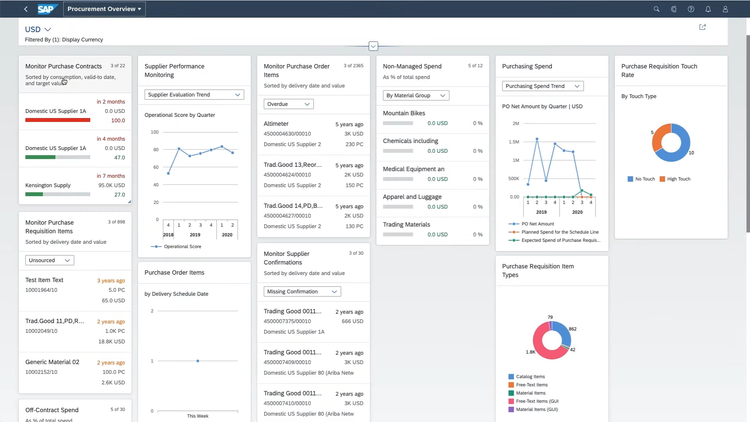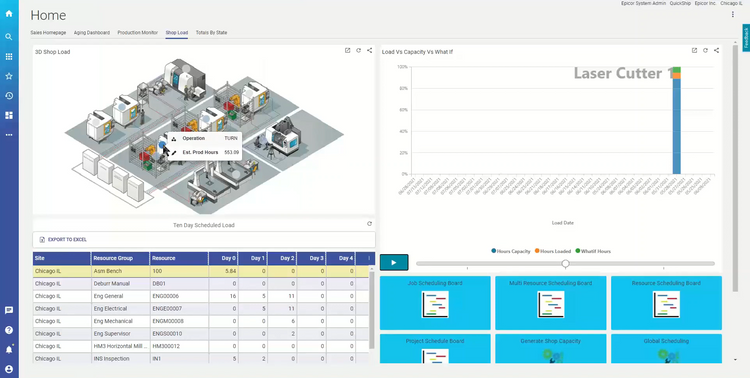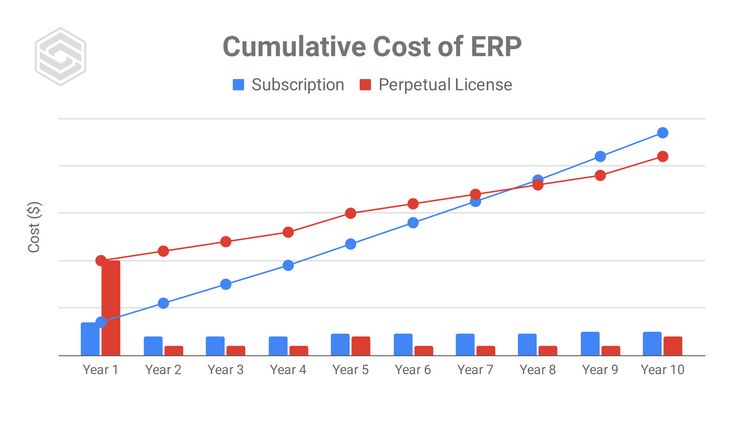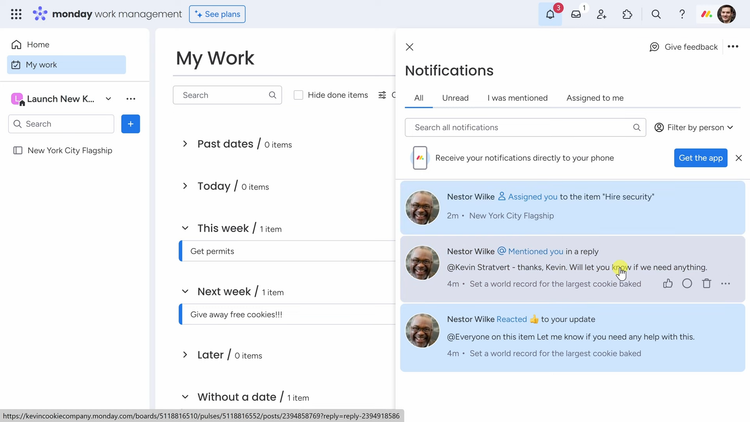10 ERP Software Trends to Watch in 2024
The top trends to watch in ERP include:
- Combine Artificial Intelligence with ERP
- Embrace the Benefits of Cloud ERP
- Integrating IoT
- Increase Mobile ERP for Remote Work
- Increased Focus on Financial Modules and Optimization
- Lower Spending to Combat Inflation
- Customization and Industry-Specific Solutions
- Integration with Microservices Architecture
- Hybrid or “Two-Tier” ERP
- Build Better Customer Relationships
1 Combine Artificial Intelligence with ERP
The rise in artificial intelligence (AI) has made it easier for companies to do things like optimize supply chain management and identify potential project risks. Machine learning, a subset of AI, allows ERP systems to analyze data, detect patterns, and forecast outcomes. However, not all ERP systems truly offer AI capabilities.
Since ChatGPT’s launch in 2022, AI has exploded in interest, pressuring many corporations to position themselves as AI-focused. In fact, a study by MMC showed that startups mentioning AI can attract up to 50% more funding. This trend has led to “AI washing,” where companies use AI buzzwords without genuine functionality.
Some ERP systems will rely on basic automation and rule-based processes rather than leveraging AI algorithms or machine learning. On the other hand, products like SAP S/4HANA fully integrate AI. For example, predictive analytics help the system forecast delivery delays and reconcile payments.
Trend Summary: Improve your business decision-making with AI, machine learning, and more ERP tools.

2 Embrace the Benefits of Cloud ERP
While plenty of businesses still use entirely on-premise ERP, there has been a steady rise in cloud-based solutions. This isn’t just because of potential cost savings: cloud technology allows companies to manage real-time business functions from anywhere with Internet access. As such, demand has increased over the years, especially as cloud platforms have become more secure and dependable. In fact, cloud-based ERP has become so common it is almost considered the default option.
There are a few holdouts to this digital transformation, with potential buyers citing fear of data loss or security breaches after ERP implementation. Yet the cloud ERP trend is undeniable. In fact, Fortune Business Insights estimates the global cloud ERP market will reach $181 billion by 2032 based on continuous improvements and growing demand.
Hybrid ERP setups are also gaining popularity as ERP vendors offer companies a way to blend on-premise systems with cloud-based applications.
Trend Summary: If you haven’t embraced cloud-based ERP, now is the time to switch - or at least go hybrid! View our best cloud-based ERP software roundup for recommendations.
3 Integrating IoT
ERP systems have become more adept at leveraging the Internet of Things (IoT) and Industrial Internet of Things (IIoT), allowing communication between interconnected technologies on shared networks. By integrating IoT, ERP systems can track inventory in real-time, helping to reduce overstock and stockouts while also cutting costs. Meanwhile, IIoT enables data collection from manufacturing sensors, optimizing machine usage and minimizing downtime.
Beyond improving operations, IoT and IIoT also support predictive analytics and decision-making. By analyzing data from IoT-enabled devices, businesses can forecast market trends, address maintenance needs before they escalate, and identify potential disruptions in the supply chain. These advancements extend their value across sectors like retail, healthcare, and agriculture – anywhere real-time data and automation are essential.
Trend Summary: Integrate IoT and IIoT for real-time data tracking and improved production processes.

4 Increase Mobile ERP for Remote Work
Just as the cloud has expanded ERP access online, mobile apps allow users to work remotely on devices like smartphones and tablets. For companies with hybrid work-from-home schedules, employees can remain in touch with work in various ways.
Even in environments requiring an in-person presence, mobile apps allow for greater connectivity between companies and their partners, vendors, and suppliers. Going out to a business lunch? Bring along a tablet with the latest figures. Catching a flight to a conference? Keep working while in the air. Have an important meeting with a client in a completely different timezone? Set it up from the comfort of your own home instead of staying at the office.
While all businesses can use apps for remote work, certain industries that heavily rely on mobile ERP to perform field services include:
- Plumbing and HVAC
- Electrical
- Roofing
- Lawn Care
- Pest Control
- Healthcare (In-Home Care)
- Property Maintenance
Trend Summary: Extend ERP functionality beyond the office to support remote work and hybrid and field-based industries.
5 Increased Focus on Financial Modules and Optimization
Budget bloat can happen slowly, increasing project costs over time until they’re unmanageable. Businesses looking to fight inflation can use ERP software to highlight their current spending patterns to find areas of waste. Financial reporting modules provide real-time data and insight on recent expenditures, past revenue, and estimated budgets so you can clearly understand all your spending.
Modern ERP can streamline many business tasks to reduce costs. As a result, businesses can reduce employees’ workloads, allowing them to spend more time on critical tasks with higher ROI. Automated reporting and forecasting modules allow for more informed decision-making at every company level.
Trend Summary: Streamline your business tasks with an ERP to reduce unnecessary spending.
6 Lower Spending to Combat Inflation
Inflation has led to considerable cost-cutting at companies of all sizes. While the total cost of ownership of an ERP system depends on various factors, it can quickly reach hundreds of thousands or millions of dollars. To save money some companies are looking for ways to save on their ERP systems.
Businesses can save by selecting the right deployment method: on-premise or cloud-based ERP systems. At first glance, cloud solutions offer more savings since they charge monthly or annually. However, on-premise ERP applications can lead to long-term savings, while cloud-based solutions offer short-term ones.
Trend Summary: Review how your ERP deployment method can reveal cost-saving opportunities.

7 Customization and Industry-Specific Solutions
When ERP software was first introduced, it used to work for everyone, from small businesses to global enterprises. Today, the one-size-fits-all approach no longer applies. While several vital modules are included in basic ERP packages, more buyers than ever are requesting some degree of customization. In fact, only 3% of companies use out-of-the-box ERP without any personalization. Instead, everyone else requests customization, from add-on modules to user interface changes. Future trends reflect even more customization as more and more new technologies become available.
In 2024, improved collaboration functionality will be a priority for ERP. Integrations between an ERP and other business software are becoming the norm, streamlining operations from one single location.
An alternative to pricey customization is to seek options made for specific industries, like:
Finally, the field of manufacturing has specific needs when it comes to ERP. In upcoming years, the industry will continue to see significant advances in 3D printing and additive manufacturing (AM). Manufacturing ERP solutions are now focusing on providing modules for addressing these methods.
Trend Summary: Customize your ERP (or select an industry-specific version) to maximize your software performance.
8 Integration with Microservices Architecture
Compatibility with services like Zoom or Slack is also on the rise to improve workplace communications. With more workers going remote, there’s an urgent need for employees to stay in touch with management in real time.
Microservices are independent add-ons that can be deployed separately from a larger platform. While they increase complexity, they can streamline communication and remote operations.
Trend Summary: Stay in touch by building microservices architecture.

9 Hybrid or “Two-Tier” ERP
Two-tier ERP is another trend aimed at increasing workplace collaboration. Originally named due to mixing a Tier 1 and Tier 2 ERP, today, two-tier ERP refers to any level ERP solutions used by a single business.
This is generally popular among enterprise-level corporations with vastly different needs between corporate offices and subsidiary branches. In these customized systems, one ERP acts as a centralized hub for data analytics, while the other allows for more focus on specific business tasks.
Learn more in our article on The 3 Tiers of ERP.
Trend Summary: Enterprise-level corporations should explore if multiple ERP systems are more efficient than one.
10 Build Better Customer Relationships
With inflation hitting consumer wallets hard, the customer experience is more important than ever. Both traditional and eCommerce stores need loyal customers in order to survive the changing market in 2024. Fortunately, customer relationship management software makes it possible to introduce new loyalty initiatives to reward returning customers, provide discount plans to consumers, or automatically send out follow-up communications to prospective clients.
Any customer-facing business can benefit from using a CRM to establish new relationships to encourage business growth. In addition, CRM solutions can operate as standalone software or an add-on module to an existing ERP for businesses looking to save on multiple software options.
Trend Summary: Use ERP and CRM to grow customer loyalty.
What Is the Future of ERP?
The future of ERP will be driven by a few factors:
- Composable ERP Systems: Companies increasingly will demand modular ERP software that allows them to build out the functionalities they need. They will construct their ERP environments by integrating core vendor-made programs and third-party applications.
- Integration with New Technologies: ERP systems will continue integrating with emerging technologies like blockchain, augmented reality (AR), and IoT. These integrations will combine to accomplish things like stronger data security and more accurate data.
- Sustainability and Green IT: As environmental concerns grow, ERP will help corporations monitor their impact. These systems will aid in resource management and compliance with green regulations.
- Cloud Dominance: Cloud-based ERP will continue to dominate the market. Hybrid models may also gain popularity, offering the scalability of the cloud with the control of on-premise systems.
- AI Integration: The integration of AI and machine learning into ERP systems will accelerate as these technologies mature. Future AI features could include ethical decision-making tools, immersive environments for data interaction, and cognitive systems capable of predicting competitor actions.
